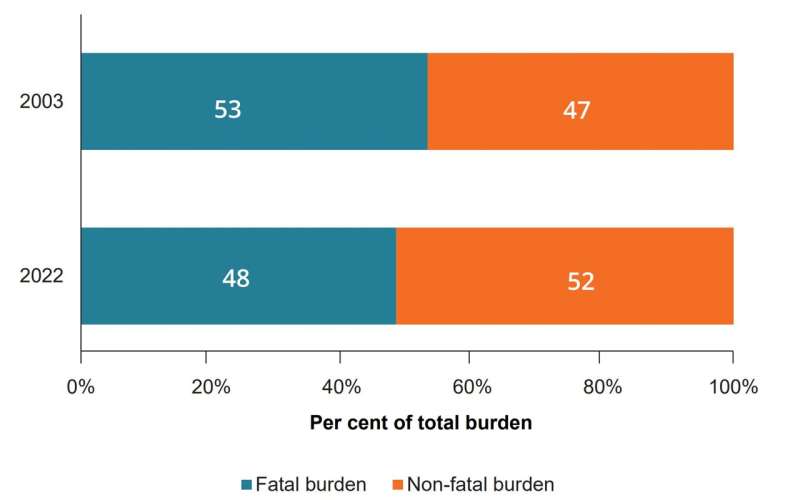Ill health on the rise in Australia for the first time in 20 years

For the first time in two decades there has been an increase in ill health experienced by Australians, as measured by the Australian Institute of Health and Welfare's (AIHW) Australian Burden of Disease Study.
The Australian Burden of Disease Study 2022 measures the years of healthy life lost by Australians by converting the impact of diseases and injuries to disability-adjusted life years (DALY), which include both the impact of living with poor health (the non-fatal burden of disease) and dying prematurely (fatal burden).
"Burden of disease studies are the gold standard for monitoring population health and Australia is a world leader in undertaking this analysis' said AIHW spokesperson Richard Juckes.
"Australians lost an estimated 5.5 million years of healthy life in 2022. Each new study since 2003 showed a decrease in the average amount of time spent in ill health by Australians, but in 2022 we saw this average increase by 2% compared with the 2018 study."
Despite the recent increase, Australians are still healthier than they were when monitoring began. Since 2003 there has been an 11% decline in DALY; fatal burden declined by 23% but rates of non-fatal burden increased slightly.
"In other words, fewer Australians are dying prematurely than 19 years ago, but we are still living with similar amounts of ill health," Juckes said.
In 2022 just under half of the harm done by diseases and other causes of ill health came from dying prematurely (48% of total burden), and just over half (52%) from the consequences of living in poor health.
For the first time in Australia, the impact of COVID-19 featured in the analysis, and it was one of the leading causes of health burden.
The estimated burden from COVID-19, including long COVID, accounted for 2.7% of the total burden in Australia. The burden from COVID-19 was predominantly from dying prematurely. It was higher in males than females, and highest in older Australians aged 75–84 years.
The top 5 specific diseases that caused burden were coronary heart disease (5.5%), dementia (4.4%), back pain (4.2%), chronic obstructive pulmonary disease (COPD) (3.7%) and anxiety disorders (2.9%). COVID-19 ranked 8th among the specific diseases.
In 2022, all cancers as a group of diseases caused the most burden (17%). This was followed by musculoskeletal conditions (13%), cardiovascular diseases (12%), mental & substance use disorders (12%) and neurological conditions (8%).
"Over the long term we have seen a large decline in the burden from dying prematurely in many disease groups. Between 2003 and 2022, fatal burden rates fell by 50% for cardiovascular diseases, cancers (26%), infant & congenital conditions (23%) and injuries (7%)," Juckes said.
"But since 2003, there has been an increase in the rate of fatal burden due to neurological conditions (42% higher), especially dementia."
"In 2022, dementia became the 2nd leading cause of total burden, moving up from the 12th spot in 2003."
The fatal burden from infectious diseases fell by 39% between 2003 and 2018 but was 143% higher in 2022.
The report builds on the Australian Burden of Disease Study: Impact and causes of illness and death in Australia 2018, which was released in November 2021.
More information: Study: www.aihw.gov.au/reports/burden … -2022/contents/about


















